When it comes to the cutting edge of solar innovation, Building Integrated Photovoltatics (BIPV) tends to lead the way. Alex Savidis, Applications Manager of Solar Capture Technologies explores the latest technologies – and crucially, materials – being used.
You could be forgiven for thinking that all solar panels have to be flat, rectangular, and made out of glass and a Tedlar backing sheet with an aluminium frame. After all, that’s the standard formula for domestic and commercial PV modules. And it’s the traditional pattern followed by pretty much all off-the-shelf solar units available to design engineers for other applications, even if they’re not really appropriate for the job. But why? Is there a good reason for the materials used to be limited in this way?
The reality is that there are plenty of alternatives that are far better suited to equipment design applications that need a different shape, size, weight, appearance or ability to cope in harsh conditions. You just need to know where to look.
A typical PV module used on house roofs, commercial buildings and solar farms is basically a laminate sandwich made up of three components – solar cells, glass and a backing sheet normally made from Tedlar – laminated together with an encapsulant. That’s fine for what they need to do. But would they all be right for integration into a traffic bollard, an offshore buoy or the approach lights used to guide a helicopter onto an oil rig?
More and more solar panels are finding their way into applications where they’re used for autonomously powering devices that can’t be connected to the grid, or where it’s too expensive to do so. But design engineers are often frustrated by the inflexibility of the standard solar units available from catalogues, and their inability to meet the specific characteristics they need – with the risk that designs end up being seriously compromised.
Shape is a common problem. Illuminated traffic bollards, for example, may need a special semi-circular curved shape that’s designed to fit perfectly into the top of the unit. Floating buoys out at sea with flashing beacons call for a circular disc design, with the solar cells arranged into a wide ring. Neither can be achieved with standard components that can only be bolted on. But although solar cells are rigid, it is possible to combine a series of “flats” to form shapes and profiles to suit the desired design.





























